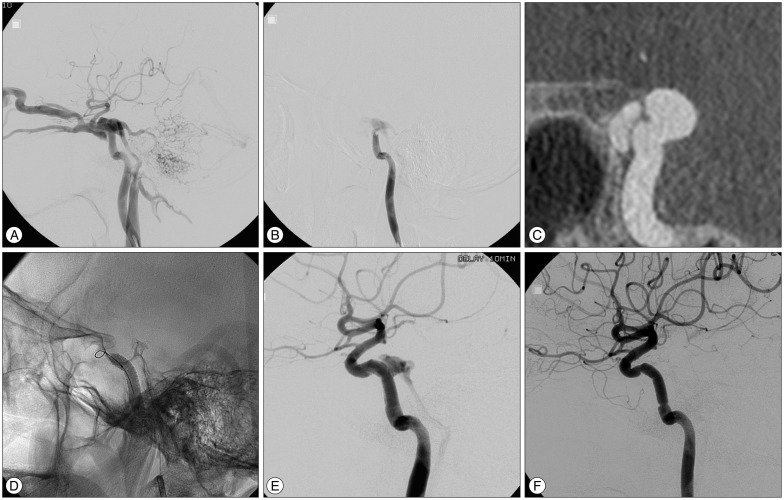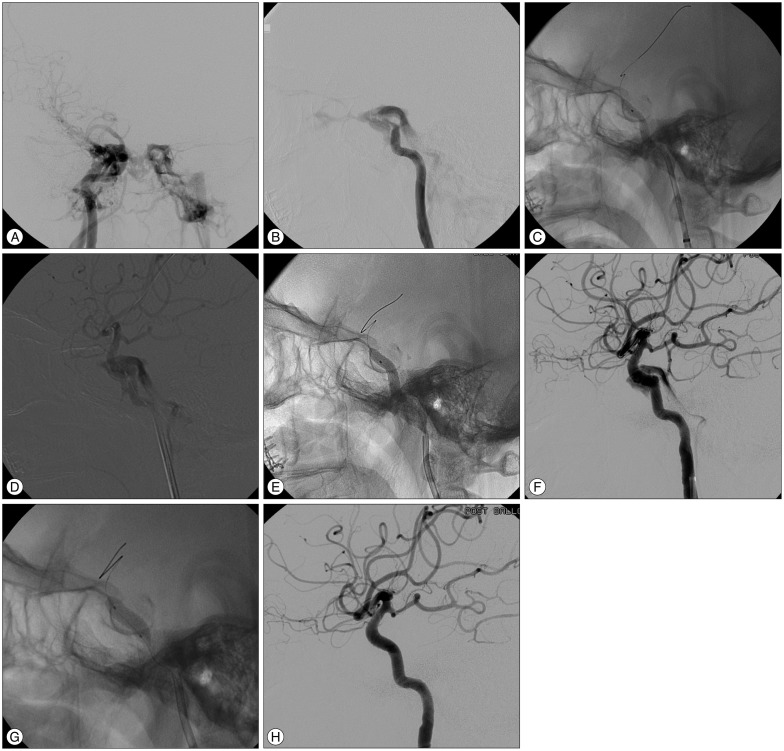J Korean Neurosurg Soc.
2015 Jan;57(1):12-18. 10.3340/jkns.2015.57.1.12.
Covered Stents for the Endovascular Treatment of a Direct Carotid Cavernous Fistula : Single Center Experiences with 10 Cases
- Affiliations
-
- 1Department of Interventional Radiology, 1st Affiliated Hospital of Dalian Medical University, Dalian, China.
- 2Department of Radiology, Seoul National University Hospital, Seoul National University College of Medicine, Seoul, Korea. aronnn@naver.com
- 3Department of Neurosurgery, Seoul National University Hospital, Seoul National University College of Medicine, Seoul, Korea.
- KMID: 2067085
- DOI: http://doi.org/10.3340/jkns.2015.57.1.12
Abstract
OBJECTIVE
Covered stent has been recently reported as an effective alternative treatment for direct carotid cavernous fistulas (DCCFs). The purpose of this study is to describe our experiences with the treatment of DCCF with covered stents and to evaluate whether a covered stent has a potential to be used as the first choice in selected cases.
METHODS
From February 2009 through July 2013, 10 patients underwent covered stent placement for a DCCF occlusion. Clinical and angiographic data were retrospectively reviewed.
RESULTS
Covered stent placement was performed for five patients primarily as the first choice and in the other five as an alternative option. Access and deployment of a covered stent was successful in all patients (100%) and total occlusion of the fistula was achieved in nine (90%). Complete occlusion immediately after the procedure was obtained in five patients (50%). Endoleak persisted in five patients and the fistulae were found to be completely occluded by one month control angiography in four. The other patient underwent additional coil embolization by a transvenous approach. Balloon inflation-related arterial dissection during the procedure was noted in two cases; healing was noted at follow-up angiography. One patient suffered an asymptomatic internal carotid artery occlusion noted seven months post-treatment.
CONCLUSION
Although endoleak is currently a common roadblock, our experience demonstrates that a covered stent has the potential to be used as the first choice in DCCF; this potential is likely to increase as experience with this device accumulates and the materials continue to improve.
MeSH Terms
Figure
Cited by 2 articles
-
Recurrent Carotid Cavernous Fistula Originating from a Giant Cerebral Aneurysm after Placement of a Covered Stent
Jung Wook Baek, Sung Tae Kim, Young Seo Lee, Young-Gyun Jeong, Hae Woong Jeong, Jin Wook Baek, Jung Hwa Seo
J Cerebrovasc Endovasc Neurosurg. 2016;18(3):306-314. doi: 10.7461/jcen.2016.18.3.306.First line Treatment of Traumatic Carotid Cavernous Fistulas Using Covered Stents at Level 1 Regional Trauma Center
Sang Hoon Jeong, Jung Hwan Lee, Hyuk Jin Choi, Byung Chul Kim, Seung Han Yu, Jae Il Lee
J Korean Neurosurg Soc. 2021;64(5):818-826. doi: 10.3340/jkns.2020.0345.
Reference
-
1. Archondakis E, Pero G, Valvassori L, Boccardi E, Scialfa G. Angiographic follow-up of traumatic carotid cavernous fistulas treated with endovascular stent graft placement. AJNR Am J Neuroradiol. 2007; 28:342–347. PMID: 17297009.2. Briguori C, Sarais C, Sivieri G, Takagi T, Di Mario C, Colombo A. Polytetrafluoroethylene-covered stent and coronary artery aneurysms. Catheter Cardiovasc Interv. 2002; 55:326–330. PMID: 11870936.
Article3. Dake MD, Miller DC, Semba CP, Mitchell RS, Walker PJ, Liddell RP. Transluminal placement of endovascular stent-grafts for the treatment of descending thoracic aortic aneurysms. N Engl J Med. 1994; 331:1729–1734. PMID: 7984192.
Article4. Debrun G, Lacour P, Vinuela F, Fox A, Drake CG, Caron JP. Treatment of 54 traumatic carotid-cavernous fistulas. J Neurosurg. 1981; 55:678–692. PMID: 6458669.
Article5. Gemmete JJ, Ansari SA, Gandhi DM. Endovascular techniques for treatment of carotid-cavernous fistula. J Neuroophthalmol. 2009; 29:62–71. PMID: 19458580.
Article6. Gomez F, Escobar W, Gomez AM, Gomez JF, Anaya CA. Treatment of carotid cavernous fistulas using covered stents : midterm results in seven patients. AJNR Am J Neuroradiol. 2007; 28:1762–1768. PMID: 17885249.
Article7. Gupta AK, Purkayastha S, Krishnamoorthy T, Bodhey NK, Kapilamoorthy TR, Kesavadas C, et al. Endovascular treatment of direct carotid cavernous fistulae : a pictorial review. Neuroradiology. 2006; 48:831–839. PMID: 16969673.
Article8. Halbach VV, Higashida RT, Barnwell SL, Dowd CF, Hieshima GB. Transarterial platinum coil embolization of carotid-cavernous fistulas. AJNR Am J Neuroradiol. 1991; 12:429–433. PMID: 2058488.9. Hoit DA, Schirmer CM, Malek AM. Stent graft treatment of cerebrovascular wall defects : intermediate-term clinical and angiographic results. Neurosurgery. 2008; 62(5 Suppl 2):ONS380–ONS388. discussion ONS388-ONS389. PMID: 18596518.10. Klisch J, Huppertz HJ, Spetzger U, Hetzel A, Seeger W, Schumacher M. Transvenous treatment of carotid cavernous and dural arteriovenous fistulae : results for 31 patients and review of the literature. Neurosurgery. 2003; 53:836–856. discussion 856-857. PMID: 14519216.11. Li J, Lan ZG, Xie XD, You C, He M. Traumatic carotid-cavernous fistulas treated with covered stents : experience of 12 cases. World Neurosurg. 2010; 73:514–519. PMID: 20920935.
Article12. Lukito G, Vandergoten P, Jaspers L, Dendale P, Benit E. Six months clinical, angiographic, and IVUS follow-up after PTFE graft stent implantation in native coronary arteries. Acta Cardiol. 2000; 55:255–260. PMID: 11041124.
Article13. Luo CB, Teng MM, Yen DH, Chang FC, Lirng JF, Chang CY. Endovascular embolization of recurrent traumatic carotid-cavernous fistulas managed previously with detachable balloons. J Trauma. 2004; 56:1214–1220. PMID: 15211128.
Article14. Morón FE, Klucznik RP, Mawad ME, Strother CM. Endovascular treatment of high-flow carotid cavernous fistulas by stent-assisted coil placement. AJNR Am J Neuroradiol. 2005; 26:1399–1404. PMID: 15956506.15. Saatci I, Cekirge HS, Ozturk MH, Arat A, Ergungor F, Sekerci Z, et al. Treatment of internal carotid artery aneurysms with a covered stent : experience in 24 patients with mid-term follow-up results. AJNR Am J Neuroradiol. 2004; 25:1742–1749. PMID: 15569740.16. Tiewei Q, Ali A, Shaolei G, Feng L, Zhongsong S, Xuesong L, et al. Carotid cavernous fistulas treated by endovascular covered stent grafts with follow-up results. Br J Neurosurg. 2010; 24:435–440. PMID: 20515263.
Article17. Wang C, Xie X, You C, Zhang C, Cheng M, He M, et al. Placement of covered stents for the treatment of direct carotid cavernous fistulas. AJNR Am J Neuroradiol. 2009; 30:1342–1346. PMID: 19342540.
Article18. Wang YL, Ma J, Ding PX, Li YD, Han XW, Wu G. Treatment of post-traumatic carotid-cavernous fistulas with the Willis covered stent. A preliminary prospective study. Interv Neuroradiol. 2012; 18:172–177. PMID: 22681732.
Article19. Zhu YQ, Li MH, Lin F, Song DL, Tan HQ, Gu BX, et al. Frequency and predictors of endoleaks and long-term patency after covered stent placement for the treatment of intracranial aneurysms : a prospective, non-randomised multicentre experience. Eur Radiol. 2013; 23:287–297. PMID: 22782569.
Article
- Full Text Links
- Actions
-
Cited
- CITED
-
- Close
- Share
- Similar articles
-
- Cerebral Hemorrhage after Endovascular Treatment of Bilateral Traumatic Carotid Cavernous Fistulae with Covered Stents
- Direct Microsurgical Repair of Traumatic Carotid-Cavernous Fistula
- Parent artery occlusion of a giant internal carotid artery pseudoaneurysm-related direct carotid cavernous fistula: A case report
- Transvenous Embolization of Cavernous Sinus Dural Arteriovenous Fistula Using the Direct Superior Ophthalmic Vein Approach: A Case Report
- Recurrent Carotid Cavernous Fistula Originating from a Giant Cerebral Aneurysm after Placement of a Covered Stent



